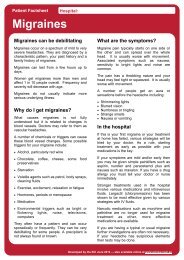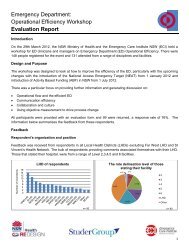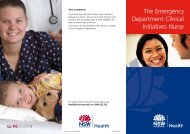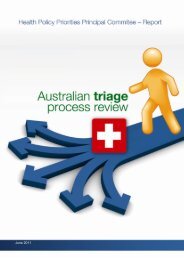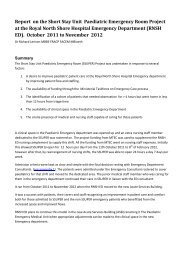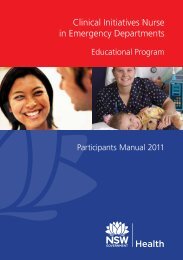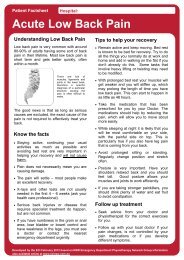Facilitators Manual - Emergency Care Institute
Facilitators Manual - Emergency Care Institute
Facilitators Manual - Emergency Care Institute
Create successful ePaper yourself
Turn your PDF publications into a flip-book with our unique Google optimized e-Paper software.
5.7 TraumaTrauma Assessment Tips Yes NoAirwayBreathingCirculationDisabilitySecondarySurvey(as above)• Assess Airway patency• Identify causes of obstruction within a trauma setting(facial fractures, burns, altered LOC)• Secure c-spine• Assess Breathing and apply oxygen• Identify life threatening thoracic injuries (tension pneumothorax,haemothorax, flial chest, penetrating wounds, tamponade,sucking chest wound) and discuss interventions• Assess circulation• Identify areas of haemorrhage (external, head, chest, abdomen,pelvis, long bones) and discuss potential intervention to stop thebleeding• Identify types of shock and discuss fluid replacement• Assess Neurological status (AVPU, pupils, GCS, limb strength)• Pain score• Expose the patient and maintain thermal control• Full set of vitals – assess RR, SpO 2, HR, BP, temp, GCS and pupils,ETCO 2 (if ETT) – maintain regular monitoring• Gadgets – ECG/Cardiac monitoring, IDC, NG/OG, BGL – Discussindications and contraindications for each• Head to Toe• Inspect the back• Jot it down – systematic documentation47Mastery Yes NoAssessor’s Nameand Designation:Assessor’sSignature:Comments:Date:INTERVENTIONS – TRAUMAClinical SkillMeasuring and applying of c-spine collarC-spine immobilisationDate MasteryAchievedName, designation andsignature of AssessorLog rollSplinting (eg. Pelvis splint, fractured mid shaft femur, limb #)Reassess ABCD post interventionPrepare for transport (internal/externalAssisting with chest tube insertion/decompression(optional – dependent on facility requirements)




